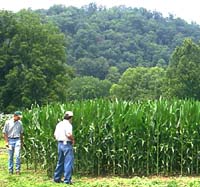Cold Temperatures, Rising Energy Prices Renew Interest in Heating With Corn
Cold Temperatures, Rising Energy Prices Renew Interest in Heating With Corn

With temperatures dipping and energy prices soaring, homeowners everywhere are turning to alternative heat sources to keep them warm this winter. Many, it seems, are turning to corn.
Even in Kentucky, where low electric rates make heating with electricity a little easier on the pocketbook, there has been a renewed interest in burning corn as a heating fuel – a practice that can be traced back at least to the Depression when farmers couldn’t afford coal.
“Corn is not only for home heating. It also has commercial and even industrial applications,” said Sam McNeill, an agricultural engineer at the University of Kentucky College of Agriculture who has fielded numerous phone calls in recent weeks from Kentuckians interested in corn as a heat source.
Both in Kentucky and nationwide, the grain crop widely grown for food is becoming so popular as a heating fuel that manufacturers of corn-burning stoves and furnaces can’t make them fast enough, said Leslie Wheeler, communications director for the Hearth, Patio and Barbecue Association in Arlington, Va.
“It’s enormous this year as people look at alternative ways to stay warm,” Wheeler said.
No doubt, corn’s resurgence as a heating fuel is due primarily to its competitive cost – currently less than $2 a bushel. If a typical corn-burning furnace uses a bushel and half a day at $2 a bushel, for instance, it would cost in the neighborhood of $330 to heat a home with a corn furnace this winter, said Robert Fehr, agricultural engineering professor at UK. By contrast, the same amount of heat would cost about $1,130 with straight electric resistance heat, $1,000 with natural gas and $628 with a typical heat pump at current prices, he said.
In addition to its affordability, McNeill said people are also discovering that corn is a plentiful and quickly renewable resource. What’s more, corn’s 70 percent heating efficiency makes it comparable to natural gas and propane and slightly better than wood.
The key to using corn effectively – and cost-efficiently – begins with finding the right corn-burning stove or furnace. Free-standing furnaces may range in price from $1,800 to $2,200, while the high-end furnaces could cost as much as $5,000, said the HPBA’s Wheeler.
Although there are corn furnaces that are designed to distribute heat throughout the house, the most popular corn-burners are conventional stoves that focus their heat on one area of the house. A typical corn-burning stove is similar to a wood-burning stove except that it is designed for a granular fuel, such as dry shelled corn.
“The general idea of how it works is no different than a stoker coal furnace was in the late ‘40s and early ‘50s,” Fehr said. “So the technology, while it’s improved, is not really anything new. Now they’re just using wood chips or pellets and corn.”
Corn-burning stoves come in a variety of styles, including fireplace inserts and space heaters. Unlike most wood-burning stoves, corn-burning stoves have a combustion air fan and a fuel stoker. The corn is held in a hopper, which can store a one-day supply to a 10-day supply.
Another key to using corn efficiently is making sure there is a plentiful supply of dry, shelled corn on hand. That may be easier said than done in urban areas, McNeill said.
“You’re going to somehow have to contract with a supplier, whether it be a farmer or a corn broker or a fuel broker, to bring corn to your house, and then you’re going to have to have a place to store it. I assume people wouldn’t want a feed-bin-looking structure in a residential area,” he said.
Despite the renewed interest in corn as an alternative heating fuel, Fehr says that Kentuckians might be wise to stick with a proven source: electricity. Electricity’s heating efficiency is 100 percent or more, and Kentucky’s electrical rates are consistently among the lowest in the nation, he said.
“The story in Kentucky is that having the lowest electric rates in the United States makes other forms of energy for heating less economical unless the fuel source is free, such as cutting your own wood,” Fehr said. “While corn furnaces sound interesting, corn will not likely stay under $2 per bushel. And until electric rates increase significantly, it might be marginally economical when compared to a heat pump.”
He recommends, instead, that Kentuckians who want to be more energy-wise when heating a home consider a geothermal heat pump.
“It represents the next increase in efficiency (up to 350 percent), taking into account our really inexpensive electric and how to better use electrical energy,” Fehr said.
For those set on buying a corn-burning stove, McNeill said it’s important to consider the initial costs of buying a corn-burning stove and a supply of corn. “You’re not going to go out and buy a stove and pay for it in a year,” he said. “That’s something to consider.”
McNeill added that corn is a renewable resource, like wood, but it is more energy intensive to grow. Consumers intent on saving energy might want to factor that in when deciding whether to heat their homes with corn.
“I can see plusses and minuses in terms of saving fuel. But you have to ask, ‘Is corn the better choice?’ … It challenges us to really think about a lot of different things rather than what’s my heating bill going to be this winter,” McNeill said.
